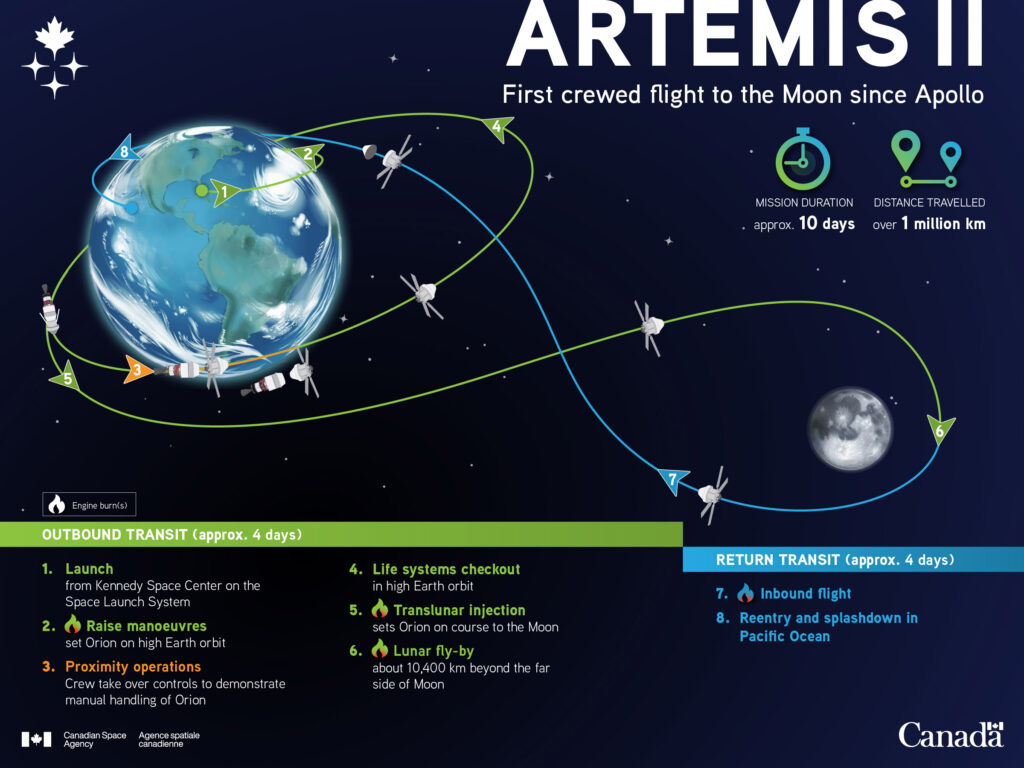Canada has a rich history in the field of space exploration, including sending nine astronauts to space and building the International Space Station‘s crucial Canadarm. Now, we’re taking one giant leap forward by sending Canadian astronaut Jeremy Hansen on board NASA’s Artemis II: the first crewed mission to the Moon since the end of the Apollo program 50 years ago.
Hansen’s role in Artemis II, which will also include the first woman and the first person of colour to participate in a lunar mission, was announced by NASA earlier this month.
A Canadian history of space exploration
In 1984, astronaut Marc Garneau became the first Canadian to go to space. Yet while a number of Canadian astronauts have followed in his footsteps in the years since, no Canadian has ever participated in a mission to the Moon — until now.
Originally from London, Ontario, Hansen was recruited by the Canadian Space Agency in 2009 through the third Canadian Astronaut Recruitment Campaign. After training for many years, Hansen’s opportunity to go to the Moon came about when Prime Minister Justin Trudeau announced Canada’s ongoing commitment to lunar exploration through the construction of a new robotic arm, the Canadarm 3.
“We are stepping up,” Trudeau said during the 2019 announcement. “Canada is going to the Moon.”
Fly me to the Moon
Now, four years after Trudeau reinforced Canada’s commitment to lunar exploration, the Artemis II mission is beginning to take shape. Following the uncrewed Artemis I mission, which launched a spacecraft beyond the Moon in 2022, Artemis II will be the first crewed lunar mission in more than five decades.
The mission — planned for approximately 10 days in 2024 — will be to complete a lunar flyby before returning to the Earth. This means that the astronauts participating in the mission will not step foot on the Moon, but will instead test the systems that will be used to land astronauts on the Moon during Artemis III: the final mission in the Artemis program, set to launch in 2025.

During the 10-day-long mission, the team’s spacecraft will follow a unique trajectory known as hybrid free return. This consists of circling the planet Earth twice in order to gain the speed necessary to travel hundreds of thousands of kilometres to the Moon. There, the spacecraft will use the Moon’s gravity to slingshot around the dark side before returning to the Earth.
Hansen’s role in the program is to act as a mission specialist alongside NASA astronaut Christina Hammock Koch — the first woman astronaut to participate in a lunar mission. Their job will be to maintain spacecraft equipment and carry out experiments during the lunar flyby, as well as to assist the pilot and mission commandor.
The knowledge the crew gains from Artemis II will then be used to plan and execute Artemis III, which will transport a human lander to the Moon’s surface. There, the astronauts will collect samples from the Moon for the first time since 1972.
Canada’s future on the Moon
In the longer term, NASA — along with the Canadian Space Agency — plans to install a permanent space station known as the Lunar Gateway in orbit around the Moon. This smaller version of the International Space Station will not only allow for longer lunar experiments, but will also one day serve as a rest stop en route to Mars.
For now, however, the Canadian Space Agency’s focus is on returning humanity to the Moon. Hansen will play a crucial role in making this happen, and will inspire Canadians during this next era of space exploration.
“I’m excited to leverage my experience, training, and knowledge to take on this challenging mission on behalf of Canada,” Hansen said in a news release.
“I’m humbled by the incredible contributions and hard work of so many Canadians that have made this opportunity a reality. I am proud and honoured to represent my country on this historic mission.”








































